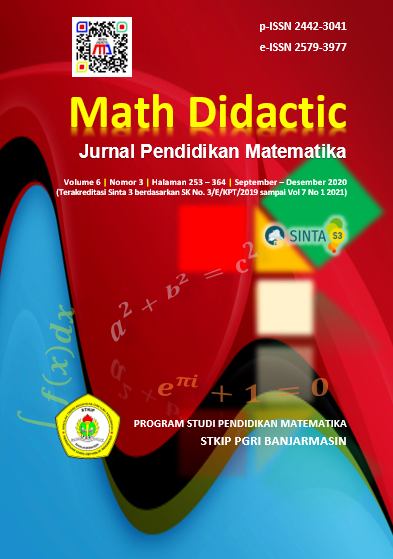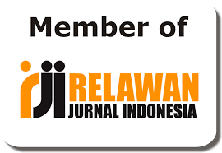Analysis of the circle concept understanding based on the learning style of deaf students at SLB Negeri 2 Bantul
Analisis pemahaman konsep lingkaran berdasarkan gaya belajar siswa tunarungu di SLB Negeri 2 Bantul
Abstrak
This study aims to describe deaf students understanding of the concept of circles based on their learning styles. The subjects in this study were 10 deaf students at SLB Negeri 2 Bantul. The research instruments of this mixed method were learning style test instrument, understanding test instrument, observation guidelines, and interview guides. Analysis of research data was carried out during and after data collection so that the data obtained were arranged systematically and were easier to interpret. In this study, quantitative data analysis was carried out through descriptive statistical analysis by presenting the results of tests of understanding and test results of student learning styles in the form of diagram. Qualitative data analysis was carried out inductively, starting with examining all data from interviews and observations, then data reduction, presentation, and verification until a conclusion was reached. Based on the results of data analysis, it is known that the learning styles of deaf students are visual, kinesthetic and a combination of both (visual-kinesthetic). From the results of the analysis it was also found that the learning styles possessed by students have a relationship and influence on the achievement of student understanding. There are four aspects of understanding the circle that students achieve with scores exceeding the minimum completeness criteria, namely aspects of interpreting, classifying, exemplifying, and comparing. Meanwhile, three other aspects of understanding, namely summarizing, explaining, and inferring are still under the minimum completeness criteria.
##plugins.generic.usageStats.downloads##
Referensi
Anderson, L. W., & Krathwohl. (2001). A Taxonomy for Learning, Teaching, and Assessing : A Revision of Bloom’s Taxonomy of Educational Objectives (Addison We). New York.
Apriliawan, A., Gembong, S., & Sanusi, S. (2013). Analisis Kesalahan Penyelesaian Soal Uraian Matematika Siswa MTs pada Pokok Bahasan Unsur-Unsur Lingkaran. JIPM (Jurnal Ilmiah Pendidikan Matematika), 1(2). https://doi.org/10.25273/jipm.v1i2.480
DePorter, B., & Hernacki, M. (2006). Quantum Learning (Edisi Revi). Bandung: Kaifa.
Fabiyi, T. R. (2017). Geometry Concepts in Mathematics Perceived Difficult to Learn by Senior Secondary School Students in Ekiti State, Nigeria. IOSR Journal of Research & Method in Education (IOSRJRME), 7(1), 83–90. https://doi.org/10.9790/7388-0701018390
Ghufron, M. N. (2013). Gaya Belajar Kajian Teoritik. Yogyakarta: Pustaka Pelajar.
Hakim, B. R., dan Haryudo, S. I. (2014). Pengembangan media pembelajaran interaktif animasi flash pada standar kompetensi memasang instalasi listrik bangunan sederhana. Jurnal Pendidikan Teknik Elektro, 3(1), 15- 21.
Landry, J. M. (2011). Learning Styles of Law Enforcement Officers: Does Police Work Affect How Officers Learn?
Prayugo, W. F. (2014). Pengaruh Penggunaan Metode Jarimagic terhadap Kemampuan Berhitung Perkalian Siswa Tunarungu Kelas IV.
Rizov, T., & Rizova, E. (2015). Augmented reality as a teaching tool in higher education. International Journal of Cognitive Research in Science, Engineering and Education, 3(1), 7–16.
Soedjadi, R. (2000). Kiat Pendidikan Matematika di Indonesia: Konstatasi keadaan Masa Kini Menuju Harapan Masa Depan. Jakarta: Direktorat Jenderal Pendidikan Tinggi, Departemen Pendidikan Nasional.
Sriadhi. (2015). Analisis Karakteristik Media Pembelajaran Dan Motivasi Berdasarkan Gaya Belajar Siswa Sekolah Menengah Kejuruan. EducanduM, VIII, 37–47.
Timutius, F., Apriliani, N. R., & Bernard, M. (2018). Analisis Kesalahan Siswa Kelas IX-G Di SMP Negeri 3 Cimahi Dalam Menyelesaikan Soal Pemecahan Masalah Matematik Pada Materi Lingkaran. JPMI (Jurnal Pembelajaran Matematika Inovatif), 1(3), 305. https://doi.org/10.22460/jpmi.v1i3.p305-312
Ula, S. S. (2013). Revolusi Belajar: Optimalisasi Kecerdasan Melalui Pembelajaran Berbasis Kecerdasan Majemuk. Yogyakarta: Ar Ruzz Media.
Wahyuni, Y. (2017). Identifikasi Gaya Belajar (Visual, Auditorial, Kinestetik) Mahasiswa Pendidikan Matematika Universitas Bung Hatta. Jurnal Penelitian Dan Pembelajaran Matematika, 10(2), 128–132. https://doi.org/10.30870/jppm.v10i2.2037
Yeni, E. M. (2011). Pemanfaatan Benda-benda Manipulatif Untuk Meningkatkan Pemahaman Konsep Geometri Dan Kemampuan Tilikan Ruang Siswa Kelas V Sekolah Dasar. Edisi Khusus, (1), 63–75. Retrieved from http://jurnal.upi.edu/file/7-Ety_Mukhlesi_Yeni.pdf






















